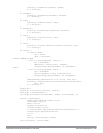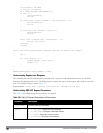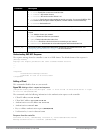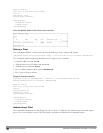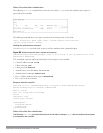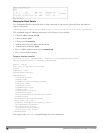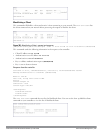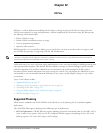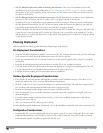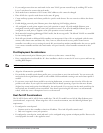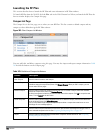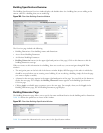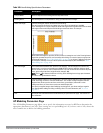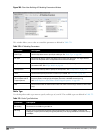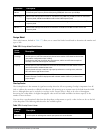
794 | RF Plan DellPowerConnectW-SeriesArubaOS6.2 | User Guide
l 802.11n Hotspot Deployment within an Existing Environment—This type of environment requires that
AP/AM locations be fixed at the building level, see "Fix All Suggested AP/AMs" on page 813. If you set and fix
the location of APs prior to planning for the 802.11n APs, the APs will not move when you initialize/optimize
the 802.11n AP locations.
l 802.11n Hotspot Deployment and New Environment—The RF Plan allows you to plan for a new deployment
that uses an 802.11n hotspot and 802.11a and/or 802.11 b/g support outside of the hotspot.
To plan for this type of deployment, start by planning your 802.11n hotspot. When you initialize and optimize
the APs planned for the hotspot, the 802.11n APs are placed within the hotspot area. However, the same AP
type will also be placed outside of the hotspot area with 802.11n support disabled.
RF Plan will deploy APs outside of the hotspot area based on the 802.11a and/or 802.11b/g rates defined by the
system. For the system to define 802.11a and/or 802.11b/g rates, the system looks at the defined 802.11n rate
and the distance covered by the defined rate; it then selects corresponding 802.11a and/or 802.11b/g rates based
on the distance covered.
Planning Deployment
Dell recommends the following when planning and deploying a mesh solution:
Pre-Deployment Considerations
l Stage the APs before deployment. Identify the location of the APs, configure them for mesh, provision them and
verify connectivity before physically deploying the mesh APs in a live network.
l Ensure the controller has Layer-2/3 network connectivity to the network segment where you plan to install the
mesh portal.
l Keep the AP packaging materials and reuse them to send the APs to the installation location.
l Verify the layout of the physical location to determine the appropriate configuration and placement of the APs.
Use this information to avoid problems that would necessitate a physical recovery.
l Label the AP before sending it to the physical location for installation.
Outdoor-Specific Deployment Considerations
l Provision the AP with the latitude and longitude coordinates of the installation location. This allows you to
more easily identify the AP for inventory and troubleshooting purposes.
l Identify a “radio line of sight” between the antennas for optimum performance. The radio line of sight involves
the area along a link through which the bulk of the radio signal power travels.
l Identify the minimum antenna height required to ensure a reliable mesh link.
l Scan your proposed site to avoid radio interference caused by other radio transmissions using the same or an
adjacent frequency.
l Consider extreme weather conditions known to affect your location, including: temperature, wind velocity,
lightning, rain, snow, and ice.
l Allow for seasonal variations, such as growth of foliage.
For more detailed outdoor deployment information, refer to the
Installation Guide
that came with your outdoor AP.
Configuration Considerations
l On dual-radio APs, you can configure only one of the radio for mesh. If you want a dual-radio AP to carry mesh
backhaul traffic and client services traffic on separate radios, Dell recommends using 802.11a radios for mesh-
backhaul traffic and 802.11g radios for traditional WLAN access.



